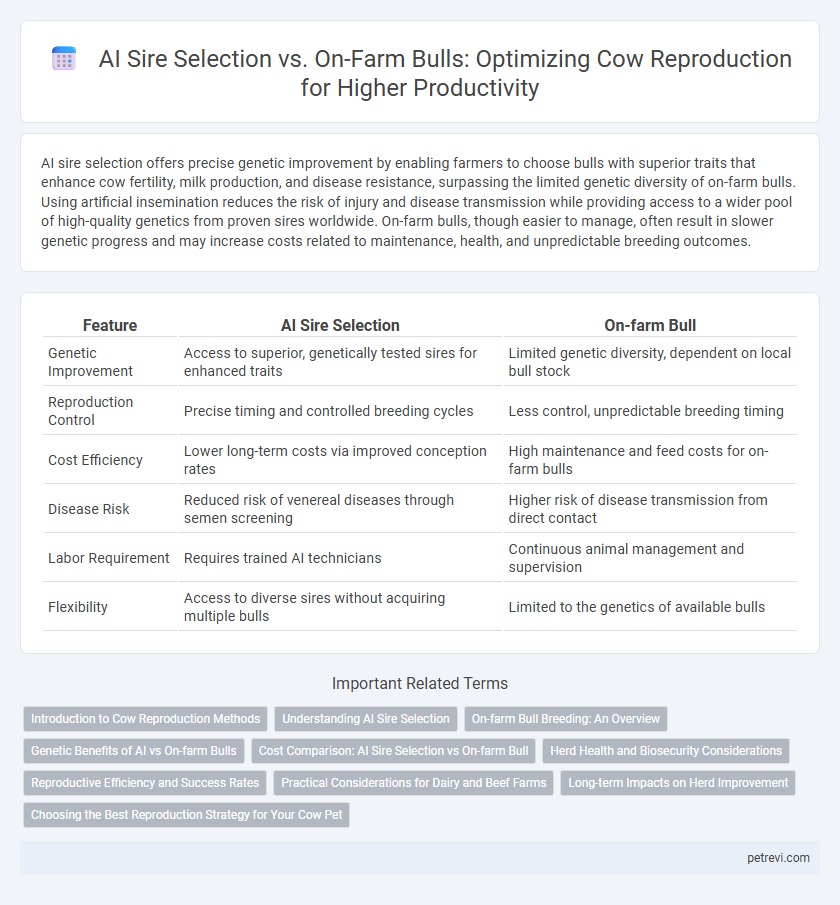AI sire selection offers precise genetic improvement by enabling farmers to choose bulls with superior traits that enhance cow fertility, milk production, and disease resistance, surpassing the limited genetic diversity of on-farm bulls. Using artificial insemination reduces the risk of injury and disease transmission while providing access to a wider pool of high-quality genetics from proven sires worldwide. On-farm bulls, though easier to manage, often result in slower genetic progress and may increase costs related to maintenance, health, and unpredictable breeding outcomes.
Table of Comparison
| Feature | AI Sire Selection | On-farm Bull |
|---|---|---|
| Genetic Improvement | Access to superior, genetically tested sires for enhanced traits | Limited genetic diversity, dependent on local bull stock |
| Reproduction Control | Precise timing and controlled breeding cycles | Less control, unpredictable breeding timing |
| Cost Efficiency | Lower long-term costs via improved conception rates | High maintenance and feed costs for on-farm bulls |
| Disease Risk | Reduced risk of venereal diseases through semen screening | Higher risk of disease transmission from direct contact |
| Labor Requirement | Requires trained AI technicians | Continuous animal management and supervision |
| Flexibility | Access to diverse sires without acquiring multiple bulls | Limited to the genetics of available bulls |
Introduction to Cow Reproduction Methods
AI sire selection enhances genetic progress by enabling precise pairing based on pedigree, health, and production traits, significantly improving herd quality compared to on-farm bull use. On-farm bulls offer natural mating simplicity and lower immediate costs but carry risks of disease transmission and less controlled genetic outcomes. Modern dairy and beef operations increasingly adopt artificial insemination to optimize reproductive efficiency, genetic diversity, and overall herd performance.
Understanding AI Sire Selection
AI sire selection utilizes advanced genetic evaluation tools, including genomic testing and comprehensive pedigree analysis, to identify bulls with superior traits for reproduction efficiency and herd improvement. This method accelerates genetic gain by selecting sires with high reliability for desirable characteristics such as milk yield, fertility, and disease resistance. In contrast, relying solely on on-farm bulls may limit genetic diversity and slow progress due to less precise selection criteria and potential inbreeding risks.
On-farm Bull Breeding: An Overview
On-farm bull breeding offers direct control over mating schedules and genetic traits, enabling farmers to optimize herd genetics through careful bull selection and management. This traditional method ensures natural breeding behaviors and reduces dependence on external technologies, which can be cost-effective for small to medium-sized farms. Maintaining a healthy, fertile bull on-site supports consistent cow reproduction cycles and promotes herd sustainability.
Genetic Benefits of AI vs On-farm Bulls
Artificial insemination (AI) sire selection offers significant genetic advantages over on-farm bulls, enabling access to superior genetics from proven high-merit sires worldwide. This technology enhances genetic diversity, accelerates herd improvement, and reduces inbreeding by allowing precise pairing of elite genetics tailored to specific production goals. On-farm bulls often have limited genetic potential and variability, constraining long-term genetic progress within cattle herds.
Cost Comparison: AI Sire Selection vs On-farm Bull
AI sire selection for cow reproduction typically reduces overall costs by minimizing expenses related to bull maintenance, feed, housing, and healthcare, which can exceed $3,000 annually per on-farm bull. While AI requires upfront costs for semen purchase and technician services, averaging $15 to $30 per insemination, it enables genetic improvement without the high fixed costs associated with owning and managing a bull. Cost efficiency improves as herd size increases, making AI a more economically viable option for large-scale dairy or beef operations compared to maintaining on-farm bulls.
Herd Health and Biosecurity Considerations
AI sire selection improves herd health by minimizing disease transmission risks compared to on-farm bulls, which carry higher biosecurity concerns due to physical contact and local pathogen exposure. Controlled semen sourcing in AI reduces introduction of infectious agents, enhancing overall reproductive biosecurity protocols. This approach supports maintaining a healthier herd environment and reduces potential outbreaks linked to bull management practices.
Reproductive Efficiency and Success Rates
AI sire selection enhances reproductive efficiency in cows by enabling precise genetic matching and access to superior bull genetics, which often results in higher conception rates compared to on-farm bulls. On-farm bulls may have variable fertility and limited genetic diversity, potentially reducing success rates and increasing calving intervals. Studies confirm that AI use consistently improves reproduction outcomes through controlled selection and optimized breeding timing.
Practical Considerations for Dairy and Beef Farms
AI sire selection offers dairy and beef farms access to superior genetics, improving traits such as milk yield, growth rates, and disease resistance, which enhances herd performance over time. On-farm bulls provide convenience and lower immediate costs but carry risks like limited genetic diversity and increased disease transmission. Practical considerations include evaluating farm infrastructure, labor availability, herd size, and genetic goals to determine the most effective reproduction strategy.
Long-term Impacts on Herd Improvement
AI sire selection offers precise genetic improvement by enabling access to superior bulls with proven traits, accelerating herd productivity and disease resistance over generations. On-farm bulls provide convenience and lower immediate costs but may limit genetic diversity and slow genetic progress due to restricted sire quality. Long-term herd improvement favors AI integration for optimizing reproductive efficiency and enhancing desirable traits consistently across the cow population.
Choosing the Best Reproduction Strategy for Your Cow Pet
AI sire selection offers precise genetic improvement by using data-driven algorithms to identify bulls with superior traits, enhancing cow reproduction efficiency. On-farm bulls provide natural mating advantages, such as reduced labor and immediate availability, but may limit genetic diversity and control. Evaluating cow herd goals, genetic potential, and resource availability is essential to choosing the best reproduction strategy for optimal herd performance.
AI Sire Selection vs On-farm Bull for Cow Reproduction Infographic

 petrevi.com
petrevi.com